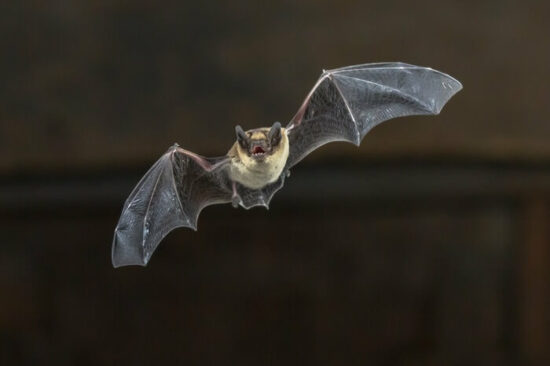Many homeowners don’t know how bats get in the house, which makes it incredibly challenging for them to deal with the problem.
This guide will teach you what attracts them to your home, how they get in, and the best ways to get them out.
Table of contents
How Do Bats Get In The House?
While most bat sightings are rare due to their nocturnal nature, these creatures are everywhere. They navigate the shadows at night and search for safe places to call home. Bats are attracted to areas that offer warmth, shelter from the weather, and protection from would-be predators.
Unfortunately, your home fits the bill! These winged animals often get into houses unnoticed, leaving a scary surprise when you stumble upon them during the day. But exactly how do bats get in the house in the first place? It turns out that they have many potential access points.
Here are some of the most common.
Vents
Homeowners usually don’t give them a second thought, but most modern homes have some form of ventilation. Without it, your home couldn’t breathe. Air circulation wouldn’t occur, making your domain pretty stuffy all year long.
Believe it or not, your home likely has several vents throughout the roof. There are two main types. These include supply and air return vents. However, more complicated homes with significant square footage might have even more!
That’s not even counting things like cooktop vents, bathroom vents, or dryer vents. Even older homes offered ventilation features in the attic to keep air moving.
As you can probably guess, those vents are a great way for bats to get into your house. While many bat species exist, most don’t need anything more than half an inch to squeeze through. As a result, standard vent slots are no match for these critters!
Bats are attracted to vents for a couple of different reasons. In some cases, it’s the movement of cool air that’s drawing them in. As night falls, warm air displaces through the vents. This creates natural suction of cool air into your home.
Bats go with the flow, following those cool currents to wherever they lead. Unfortunately, the air often leads directly into your attic.
Another reason why bats use vents is because of the warm air inside. As the temperature falls in the fall and winter months, bats must find a safe place to settle down. Your home’s temperature is a stark contrast to what’s going on outside.
Bats can detect the difference through the vents, making it the perfect bat attractor.
Quick Tip: So, how do you prevent bats from using your home’s vents? The easiest solution is to use vent covers. As the name would imply, these accessories fit directly onto the ventilation holes to stop any creatures from getting in.
Chimneys
Like your vents, chimneys are a haven for bats, and one of the most likely ways they can get in your home. In fact, chimneys are one of the most notorious bat hideouts there are! It’s not uncommon to see female bats setting up roosts and having babies inside unused chimneys.
Even if they don’t set up shop directly in the chute, chimneys can be used by these animals for easy access to your home. You’re most likely to see them in your chimney around the summer season.
Quick Tip: Females tend to give birth in May or June. As a result, they search for roosting spots beforehand.
They may appear as the temperature drops as well. Big brown bats start to hibernate in October, and your chimney is the perfect way to get into your home.
The best way to stop bats from getting into your home through the chimney is to install a cover. Like ventilation accessories, the cover physically prevents animals from getting in. However, it won’t restrict airflow or prevent you from using your fireplace.
Fascia Boards
Not sure what the fascia is? You’ve likely seen and interacted with it tons of times without knowing its name. The roof fascia is that horizontal board that sits right under the roofline.
It’s just one of many parts of the transition between the roof and the exterior wall. However, the thing that makes it unique is that it’s the most visible part of the structure.
The fascia is what holds up the last row of roof tiles and supports rain gutters. You might even use the fascia to mount holiday lights or satellite dishes if you have them!
Usually, the fascia board is well-protected and durable. But like any other part of your home, it can experience damage over time. Constant weather exposure and general wear can lead to warping.
When this happens, it’s not hard for bats to use them to get in the house. Once past the fascia, they have direct access to the trusses and the framing underneath. From there, it’s pretty easy for the bats to get into your attic or main living space.
If they don’t enter through the fascia, they may use the soffit. The soffit and fascia are two different roofing elements, but they go hand in hand. The soffit is the section that connects the roof to your home’s exterior wall.
Take a look at your roofline. You likely have a slight overhang. The bottom part of the overhang that you can see is the soffit!
Once you identify this element, it’s not hard to see how bats take advantage of it to get in. Like the fascia, it can experience damage over time.
While most homeowners only use the fascia to support accessories, the adjacent soffit gets a lot of exposure to the elements. Warping, rotting, and general disrepair makes it easy for bats to find an entry point.
Always inspect the fascia and soffit. Replace any components that look worse for wear. Otherwise, it’s only a matter of time before the bats come in!
Old Damaged Roofs
Speaking of vulnerable roof elements, have you checked the quality of your roof tiles? Whether you have traditional asphalt shingles, durable metal, or fancy slate, nothing is immune to damage.
Your roof itself takes a beating. Despite the durable materials and design, it’s only a matter of time before Mother Nature’s beating takes its toll. When that happens, the bats are waiting and ready to take advantage.
Damaged shingles are surprisingly easy access points that bats can use to get into your house. Bats are agile enough to move them out of the way if need be. Damaged wood isn’t much of a match for them, either.
Quick Tip: Remember, these winged critters can squeeze through gaps the size of a dime.
Don’t forget to inspect your roof regularly. If you’re not keen on getting up there yourself, there are plenty of professionals who will do it for you! Address broken shingles and damaged wood.
Even minor chipping, peeling, or cracking are causes for concern. Please don’t ignore them! In addition to letting bats and other pests in, damage can lead to some costly water leaks.
Gaps
This one is a bit of a broad bat access point, but it’s worth mentioning. Small gaps in your home’s exterior are perfect access points for bats to get in your home.
What kinds of gaps are we talking about? Realistically, voids can form all over your home’s shell. The exterior walls are some of the toughest. But like anything else, they can sag and settle the longer your house stands.
New homes are tight and perfectly sealed from the elements. However, materials can shift over the years, resulting in small gaps around doors and windows.
Commonly used openings like those are the worst offenders. The constant use mixed with unique framing is a recipe for worsening structural issues over time.
Pests of all types will utilize those gaps to experience the comfort of your house. Bats are no exception!
As always, never ignore those seemingly innocent structural problems. If something looks off, address it. You don’t have to go all out and reframe your windows to protect your home from bats.
Quick Tip: Sealant and caulk work just fine! The issue is spotting those openings and taking care of them before bats notice the potential!
Open Windows
This might seem like an obvious one, but hear us out!
You’d be surprised by how often bats get into homes through open windows. We’ve all popped windows open to get some cross ventilation and fresh air. There’s nothing wrong with that.
The issue is that most homeowners don’t sit and watch what comes through the open window! It doesn’t take much time. Bats can quickly zip right in when you have your back turned.
It can happen even if you open the window a crack.
Luckily, adult bats tend to be smarter than to fly into a well-lit room through the window. These flying mammals don’t want anything to do with you either, so they tend to avoid open windows when a lot is happening inside.
That said, youngsters aren’t so bright. You’re most likely to spot bats entering your window after the pupping season. Females give birth in May and June. By late summer, the juveniles are learning to fly and hunt.
It’s not uncommon for young bats to stray away from the comforts of their mother. They often get separated, leaving the babies to make some not-so-smart choices. Those are the ones you have to worry about most when you have an open window!
Luckily, this issue is easy to avoid. Don’t leave your windows open overnight. Bats are most active once the sun goes down.
It also pays to have a screen. Screens offer ample protection and give you some peace of mind even during the dark.
Holes In Siding
Siding is another component that could cause trouble when it degrades.
Your home’s siding is the first line of defense against the elements. It protects the framing from moisture and offers a bit of insulation. Plus, it gives your house its signature curb appeal!
This building material has gone a long way in the last few decades. Nowadays, fiber cement, vinyl, and other durable materials are capable of outliving you! However, cheaper and older alternatives pose significant problems.
Wood siding, for example, is notorious for rotting if not adequately maintained. As it rots, bats can push right through the decaying material to enter your home. On top of that, damaged siding can expose all kinds of gaps and hiding spots!
Many bats will be attracted to those tiny holes as a way to get out of the elements. There, they can roost in the framing of your exterior wall. Some even use any insulation that’s available to create a cozy little nest.
There’s not much separation between you and the bats once they get through the siding. There’s a considerable risk of them breaking into your living space, so you should address siding issues as soon as possible.
Quick Tip: Repair broken pieces and consider upgrading to more durable options. While no material is indestructible, stronger siding materials are less likely to contribute to a bat problem.
How To Get Bats Out Of Your House
If you’re unfortunate enough to see a bat that got into the house, there are several things you can do. Never let a bat live in harmony with your family.
While these creatures don’t want anything to do with you, they can transmit diseases. Because they like to nest together, it doesn’t take long for your home to become a popular spot for these pests.
Use the following tips to get rid of any bats you see and reclaim your home.
Find The Access Point
First, you need to figure out how bats are getting into your house.
The easiest way to do this is to look for the messes they leave behind. Bat droppings and body oil are pretty easy to spot. They look like dark black spots on the floor.
A heavy concentration of those spots indicates a potential nesting area. Bats typically urinate and defecate in the same room, so you should have no problem spotting accumulated waste.
Follow the path of waste these creatures create, and you might find how they’re entering and leaving.
Pay close attention to the entry points we went over as well. Once you find the entry point, consider making a note of it!
You don’t want to close the spot right away. Before you do that, you’ll need to get rid of the existing bats.
Protect Yourself & Your Family
Protection is vital when dealing with bats. These winged animals can bite, scratch, and transmit disease. They’re also known carriers of rabies, so you must take precautions when dealing with them.
Keep all pets and children as far away from the roosting areas as possible. Close off all doors, too. That way, the bat can’t escape to another room.
For yourself, put on a pair of thick gloves.
Hire Professionals
Before we go any further, it’s often a good idea to call a professional to deal with bats. Even small bats can be dangerous, and professional exterminators already have the tools to take care of them.
While you can continue to a DIY approach, you should get some expert help if you’re not confident in your abilities to tackle this issue. Your safety is worth so much more than whatever an exterminator charges, so don’t hesitate to give them a call to be on the safe side.
Encourage A Natural Exit
The best way to get rid of bats that have gotten into your house is to encourage them to exit on their own. The less physical contact you have with these critters, the better.
Start by opening up windows that lead outside. Seal off doors to other rooms so that the bats have no choice but to go out.
Now, shine a light in its direction. You can also make some banging sounds, but that can be hit or miss. The goal is to scare it a bit so that it leaves its hiding spot and flies away.
Once they take flight, stick to the walls! Bats like to fly in a U-shaped pattern. They rise towards the walls and dip low in the middle of the room.
Keeping close to the room’s perimeter will prevent an accidental collision.
Quick Tip: If the light doesn’t keep the bat away, go the opposite route. Bats are more active at night, so turning off the lights might trigger them to leave.
There’s a good chance that any bat you find is well aware of your presence. As a result, most aren’t going to hesitate to leave once it realizes you’ve spotted them.
Use Traps
If all else fails, you could use a trap. Here’s where a professional exterminator is most beneficial. We don’t recommend trying to catch and release a bat on your own! Doing so is only asking for trouble!
Exterminators can use many different kinds of traps. Professional-quality units are usually much safer. However, some will use cardboard boxes or large plastic containers.
Either way, trapping makes it easy to physically remove a bat that has gotten into your home and release it to a safer spot.
Take Measures To Prevent Reentry
After that ordeal is over, you’ll need to make it harder for bats to get into your house.
Start by cleaning up droppings and waste. Do so carefully. Pathogens and bacteria run rampant, so use gloves and plenty of disinfectants.
Go back to the access point you found earlier and address it. It doesn’t hurt to do a full inspection of your home to find other potential entryways, too. Whether bat-proofing requires siding repairs, roof work, or the purchase of some chimney covers, take steps to prevent future infestations.
It might seem like a lot of work now, but the peace of mind you’ll get is well worth the trouble.
Conclusion
Now that you know how bats get in the house, it will be far easier for you to keep them away. These little animals aren’t being malicious, so it’s simply a matter of making sure there’s no reason for them to be attracted to your home.
If you’re having trouble with bats and want some additional feedback, send us your questions. We’re always happy to help and give you some extra tips.


